calsfoundation@cals.org
Ozark Hellbender
aka: Cryptobranchus alleganiensis bishopi
The salamander called the Ozark hellbender (Cryptobranchus alleganiensis bishopi) is one of two subspecies of hellbender (Cryptobranchus alleganiensis). Historically, the eastern hellbender (C.a. alleganiensis) is found throughout much of the upland areas of the United States east of the Mississippi River; it also inhabits northern portions of the Ozark Mountains of Missouri. The Ozark hellbender occurs in several southern-flowing streams of the Ozark Mountains of Missouri and has a very restricted range in Arkansas, occurring only in the upper reaches of the Spring River, in portions of the Eleven Point River in Randolph County, and in the White River at Batesville (Independence County) and near the town of Norfork (Baxter County).
The hellbender, North America’s largest salamander, sometimes grows to almost two feet in length and weighs up to six pounds. This species possesses some unique morphological and behavioral traits essential for its survival. As a permanently aquatic species, which has adapted to cool, fast-flowing streams and rivers, the hellbender utilizes its conspicuous lateral body folds to enhance cutaneous respiration (that is, breathing through the skin). With its dorso-ventrally flattened body, the hellbender squeezes itself under large boulders, within crevices, and beneath submerged debris. The boulders, in particular, provide year-round shelters for its secretive behavior during daylight hours and for nesting sites during the breeding season. As a habitat specialist, the hellbender is vulnerable to environmental changes and cannot adapt well to any dramatic habitat alterations. The availability of optimal microhabitat conditions, therefore, may dictate the presence of hellbenders and the density of their populations, and may well represent the most important limiting factor for its continuing existence.
A precipitous decline in Ozark hellbender populations since the 1990s prompted the elevation of this species to “proposed endangered” status, opening the possibility for future designation as endangered or threatened. Recent surveys have shown that Ozark hellbender populations are still present at some historic localities, although the actual numbers of salamanders are greatly reduced in these populations. These surveys have shown that size class distributions are skewed toward large, old adults indicative of senescent (aging) populations with little or no recruitment, or the addition of surviving juveniles to the population.
Based on the current inability to achieve successful captive reproduction, it will be necessary to take a new approach in observing and monitoring breeding/nesting activity in wild populations and, in turn, apply new information gained from these observations to captive propagation efforts. In general, hellbenders lay their eggs under large cover rocks in cavities excavated by the male, who then guards the eggs until they hatch. The most productive method for conducting hellbender surveys is to turn over these cover rocks, but many are too large to safely overturn and turning cover rocks with courting hellbenders or nests under them is disruptive to courtship behavior or can cause the loss of the egg mass.
Recent efforts toward hellbender conservation in Arkansas and Missouri rivers have been focused on monitoring known populations, locating new populations, evaluating habitat characteristics, and developing a hatching and head-starting regime for future population supplementation. The latter project has proven to be the most difficult, yet has the most potential to aid in the conservation of the Ozark hellbender.
Conservation efforts to save the Ozark hellbender from extinction reached a high point in November 2011. Not only was the Ozark hellbender declared a federally endangered species (November 5), but also researchers at the St. Louis Zoo, in collaboration with the Missouri Department of Conservation, successfully bred the Ozark hellbender in captivity for the first time at the Ron Goellner Center for Hellbender Conservation. The first hatched eggs from an egg clutch of approximately 120 eggs were obtained on November 15, 2011. These two events mark a major turning point in hellbender conservation.
For additional information:
Nickerson, Max Allen, and Charles Edwin Mays. The Hellbenders: North American “Giant Salamanders.” Milwaukee, WI: Milwaukee Public Museum, 1973.
Trauth, Stanley E., J. D. Wilhide, and Patrick Daniel. “Status of the Ozark Hellbender, Cryptobranchus bishopi (Urodela: Cryptobranchidae), in the Spring River, Fulton County, Arkansas.” Proceedings of the Arkansas Academy of Science 46 (1992): 83–86.
Trauth, Stanley E., Henry W. Robison, and Michael V. Plummer. The Amphibians and Reptiles of Arkansas. Fayetteville: University of Arkansas Press, 2004.
Wheeler, Benjamin A. “The Status, Distribution, and Habitat of Cryptobranchus alleganiensis bishopi in Arkansas.” PhD diss., Arkansas State University, 2007.
Stanley E. Trauth
Arkansas State University
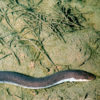 Amphibians
Amphibians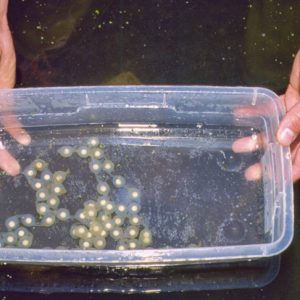 Hellbender Eggs
Hellbender Eggs 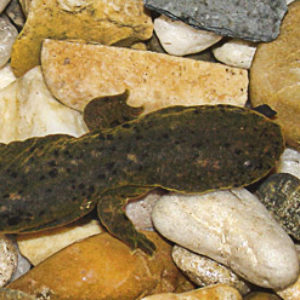 Juvenile Ozark Hellbender
Juvenile Ozark Hellbender 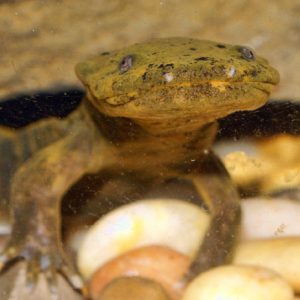 Ozark Hellbender
Ozark Hellbender  Ozark Hellbender
Ozark Hellbender 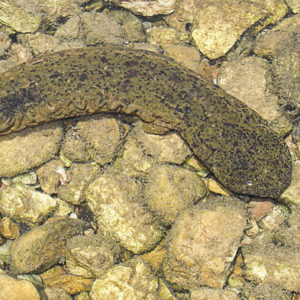 Ozark Hellbender
Ozark Hellbender 




Comments
No comments on this entry yet.